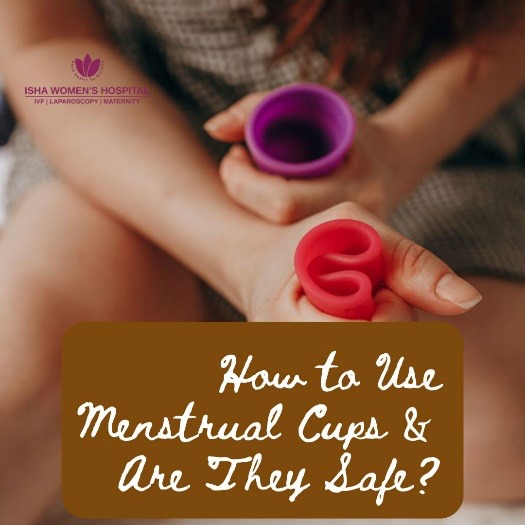How to Use Menstrual Cups & Are They Safe?

A menstrual cup is a small, flexible, medical-grade device designed to collect menstrual fluid instead of absorbing it. But despite its many benefits, questions about how to use it correctly and whether it's safe still linger in many minds.
In this blog, we’ll walk you through everything you need to know about menstrual cups—how they work, how to use them, how to care for them, and whether they’re the right fit for your body. Whether you're curious, hesitant, or ready to make the switch, this comprehensive guide will help
What Is a Menstrual Cup & Why Use One?
What Is a Menstrual Cup?
A menstrual cup is a small, soft, and flexible funnel-shaped cup designed to be inserted into the vagina during your menstrual cycle to collect rather than absorb menstrual fluid. Unlike pads or tampons, which are disposed of after each use, menstrual cups are reusable.
These cups are typically made of:
- Medical-grade silicone – gentle on the body and safe for long-term use.
- Rubber – more flexible, but not suitable for those with latex allergies.
- Thermoplastic elastomer (TPE) – a hypoallergenic alternative used in some brands.
Benefits of Using Menstrual Cups
- Eco-friendly - One menstrual cup can last up to 10 years, significantly reducing period waste.
- Cost-effective - Though the initial cost is higher, it saves thousands of rupees over time.
- Longer wear time - Can be worn for up to 12 hours, depending on your flow — fewer bathroom trips!
- Less odor - Since menstrual fluid is sealed inside the cup, there's less exposure to air, reducing odour.
- Lower risk of irritation - Menstrual cups are free from bleaches, perfumes, and chemicals, reducing skin irritation.
- Holds more fluid - A cup holds more than tampons or pads, making it ideal for women with heavy periods.
The shift toward menstrual cups isn’t just a trend — it’s part of a growing movement towards body autonomy, sustainability, and comfort. They offer a reliable, discreet, and eco-conscious alternative to traditional menstrual products. For active women, travellers, or anyone tired of changing pads frequently, menstrual cups offer unmatched freedom.
How to Use a Menstrual Cup Correctly
Getting used to a menstrual cup may take a little practice, but once you master the technique, it can be one of the most comfortable and convenient menstrual hygiene options available. This section will guide you through how to insert, remove, and maintain your menstrual cup properly and safely.
How to Insert a Menstrual Cup (Step-by-Step)
Here’s a step-by-step guide to inserting your cup comfortably:
Step 1: Wash Your Hands & Rinse the Cup
Always begin by thoroughly washing your hands with soap and water. Rinse the cup with clean water to remove any dust or residue, especially if it’s been stored for a while.
Step 2: Fold the Cup
There are several folding techniques to make insertion easier. Try a few and see what feels best for you:
- C-Fold: Press the cup in half to form a “C” shape.
- Punch-down Fold: Push one side of the rim into the base to make a narrow point.
- 7-Fold: Flatten the cup and fold one corner down diagonally.
Find a comfortable position — sitting on the toilet, squatting, or standing with one leg raised. Gently insert the folded cup angled towards your tailbone, not straight up.
Step 4: Let It Pop Open and Seal
Once inside, the cup will unfold and create a gentle seal against the vaginal walls. This seal is what prevents leaks.
Step 5: Check the Placement
Run a finger around the base of the cup to make sure it has fully opened. Gently rotate the cup or move it slightly up and down to ensure its secure.
Tip: Try inserting the cup during a lighter flow day or use a water-based lubricant to ease the process if you’re new to using it.
How to Remove a Menstrual Cup Safely
Step 1: Wash Your Hands
Clean hands prevent introducing any bacteria into the vaginal area.
Step 2: Pinch the Base
Reach in and pinch the base of the cup (not the stem!) to break the seal. This is key to comfortable removal.
Step 3: Gently Pull Out
While pinching the base, slowly pull the cup out while keeping it upright to avoid spills. Use a gentle, side-to-side motion if needed.
Step 4: Empty and Rinse
Pour the contents into the toilet. Rinse the cup with water and a fragrance-free mild soap before reinserting.
Tip: Avoid pulling the cup by the stem alone — this can be uncomfortable and may cause suction, making removal harder.
How Often Should You Empty It?
The frequency of emptying your menstrual cup depends on your flow, but here are some general guidelines:
- Every 4 to 12 hours, depending on how heavy your flow is.
- Most women can wear it overnight safely for up to 8–12 hours.
- At a minimum, empty and rinse it twice a day to maintain hygiene and prevent odour or leakage.
It’s perfectly normal to need a few cycles to fully adjust to using a menstrual cup. Be patient with yourself. The comfort, cost-saving, and sustainability it offers make the initial learning curve well worth it.
Safety, Cleaning & Common Concerns
- Are Menstrual Cups Safe? Yes — when used correctly, menstrual cups are completely safe and approved by multiple global health authorities. Here’s why you can trust them:
- Backed by Research: Studies published in medical journals and endorsements from organizations like the World Health Organization (WHO) and the American College of Obstetricians and Gynecologists (ACOG) confirm their safety and effectiveness.
- Lower Risk of Toxic Shock Syndrome (TSS): Unlike tampons, which absorb fluid and can increase the risk of TSS when left in too long, menstrual cups collect fluid and are less likely to create a breeding ground for bacteria.
- Safe for All Ages and Stages: Menstrual cups are safe for virgins, teens, and postpartum women (once cleared by a doctor). Many brands offer different sizes and firmness levels to suit individual needs.
Choose the Right Cup for Your Body: Most brands offer two sizes:
- A smaller size for teens or women under 30 who haven’t given birth.
- A larger size for women over 30 or those who’ve had a vaginal birth.
How to Clean and Care for Your Cup
During Your Period
- After removing your cup, rinse it thoroughly with water.
- Use a mild, fragrance-free soap (specifically formulated for intimate hygiene or menstrual cups).
- Avoid soaps with strong perfumes or harsh chemicals as they can irritate sensitive vaginal tissue.
- At the end of your cycle, sterilize the cup by boiling it in water for 5–10 minutes. Make sure it doesn’t touch the bottom of the pan to prevent melting.
- Let it air dry completely.
- Store your clean, dry cup in a breathable cotton pouch (usually provided by the manufacturer).
- Avoid airtight containers, which can trap moisture and encourage bacterial growth.
Common Myths & FAQs About Menstrual Cups
- It’ll get lost inside me - It’s physically impossible. The cup sits below the cervix, which acts as a barrier.
- Not suitable for virgins - Menstrual cups can be used by virgins with care. opt for smaller, softer cups and take your time.
- It hurts to insert - With the right folding technique, gentle insertion angle, and maybe a little water-based lubricant, insertion should be painless.
- Cups are messy - Not more than tampons or pads. With practice, insertion and removal become clean and easy.
- Menstrual cups cause infections - When cleaned properly and emptied regularly, menstrual cups are hygienic and safe.
Choosing the Right Menstrual Cup for You
Factors to Consider When Buying a Menstrual Cup
Not all menstrual cups are created equal. To find the right one for you, consider these key factors:
Cervix Height: Your cervix changes position throughout your cycle. During your period, insert a clean finger to measure how high your cervix sits.
- Low cervix = shorter, softer cup
- High cervix = longer, firmer cup
- If you have a heavy flow, go for a higher-capacity cup (often labelled as “large” or “high capacity”).
- If your periods are light or moderate, a smaller cup will work just fine.
- Softer cups are ideal for those with sensitive bladders or pelvic floor issues, as they put less pressure on surrounding tissues.
- Firmer cups pop open more easily and are great for physically active users, such as athletes or yoga enthusiasts.
- Women who have given birth vaginally or are over 30 often need a larger cup due to changes in pelvic anatomy.
- Teens and women who haven't given birth may prefer a smaller, more flexible option.
Here are a few well-known menstrual cup brands you might consider:
- DivaCup – widely available, great for beginners
- Saalt – soft, sustainable, and comes in various sizes
- Lunette – medical-grade silicone with a smooth finish
- Sirona – affordable and made for Indian users
- SheCup – reusable, durable, and beginner-friendly
Alternatives If a Menstrual Cup Isn’t Right for You
Menstrual Discs
- Similar concept but sit differently in the vaginal canal.
- Can be worn during intercourse and offers up to 12 hours of protection.
- Comfortable and eco-friendly.
- Great for overnight use or combining with cups/discs for added confidence.
- Perfect for beginners still getting used to internal options.
- Widely available and easy to use.
Switching to a menstrual cup might feel like a big leap at first, but with the right information, a little patience, and some practice, it can become one of the most empowering decisions you make for your health. From reducing waste to saving money and gaining more freedom during your periods, menstrual cups offer a modern, body-friendly solution that’s worth exploring.
If you have concerns about choosing the right size or using it correctly, don’t hesitate to reach out to the experts. At Isha Women’s Hospital, our team of experienced professionals, led by Dr. Chinmay Pataki, the best gynaecologist here, to guide you every step of the way. Whether you're a first-timer or simply looking to explore better menstrual care, we're just a consultation away.
Your comfort, health, and confidence matter. Let’s make periods easier—together.
Frequently Asked Questions (FAQs)
Ans - Yes—they are safe for teens, just choose a smaller size and learn proper technique.
2. Can I pee with a menstrual cup in?
Ans - Absolutely! It doesn’t block your urethra, though it may apply slight pressure.
3. Can a menstrual cup get stuck or lost?
Ans - No—the cervix prevents it from going anywhere beyond the vaginal canal.
4. Can I use it with an IUD?
Ans - Yes, but consult your doctor to avoid dislodging the IUD when removing the cup.
5. How long does a menstrual cup last?
Ans - With good care, up to 10 years.
